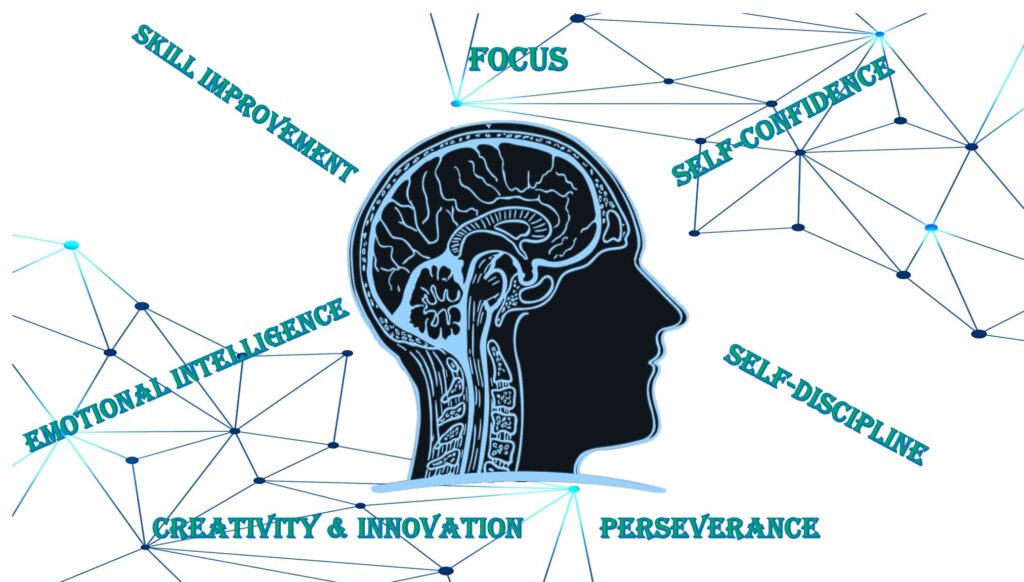Exercise Boosts Brain and Mental Health: How to Keep Your Mind Sharp


By Robert G. Jesky, PhD | Oct. 29, 2022 | Performance |
Brain health is of utmost importance to our overall well-being. Not only does it help us think more clearly, but it also helps us stay active, feel better and live longer. In other words, a healthy brain means a whole lot more than just being able to think clearly or spout off witty rebuttals. The brain is an electrical organ that needs regular activity as well as nutrients in order to stay healthy. When the brain is given proper amounts of these it is able to function at its peak capacity. In other words, a healthy brain means an active one. The human brain is a muscle, and it needs to be exercised in order to stay healthy. In order to perform optimally, our brains need a healthy diet, but equally so it needs things like new experiences, challenges, and goals. This is why physical exercise plays such an important role in keeping your brain healthy and functioning at its best. In this blog post, I will explore the known benefits of including physical exercise in your daily routine and how exercise boosts brain and mental health, different types of physical exercise that maintain and improve brain health, how much physical exercise you should be doing each week and what the potential side effects are if you overdo it with physical exercise.
What are the Benefits of Physical Exercise on Brain Health?
Physical exercise is critical for keeping our bodies healthy and functioning optimally. It helps us maintain good muscle mass, stay strong and increase fitness. The wonders exercise exerts on the brain are numerous, far too many to list here, but a few notable benefits are as follows:
- Improve Mental Health – Exercise can help regulate mental health by reducing anxiety and depression, elevating mood, and improving self-esteem, and does so by increasing essential neurotransmitters in the brain such as endorphins, serotonin and dopamine.
- Boost Cognitive Health – Regular physical activity improves brain health by increasing essential growth factors like brain derived neurotrophic factor (BDNF), which promotes neuronal survival, facilitates neuroplasticity, and also helps reduce stress and anxiety.
- Improve Learning and Memory – Habitual exercise has been shown to improve memory and the speed and accuracy of information processing. How this is achieved is rather diverse, but to give you an idea it is attributed to secreted exerkines (i.e., hormones, metabolites, proteins) and elevated neurotrophic factors and their signaling pathways that drive functional and structural plasticity in the brain. This allows new and/or existing brain circuits to be linked together, synchronized, and modified towards increasing efficiency. Hence, improved learning ability and better memory.
- Strengthen Mind-Body Connection – The varied movements associated with physical activity create enhanced mind-body awareness through improved coordination, balance, breathing, focus and attention.
- Enhance Mental Clarity – Regular physical exercise helps to do away with brain fog and fuzzy thinking. Contracting muscles repeatedly produces various exerkine molecules and elevating our heart rates as done during exercise increases blood flow and oxygen levels to the brain which in turn shuttles these and other essential nutrients to the brain enriching it in the process. On the other hand, the increased blood flow and dilation of your blood vessels aids the removal of pollutants; together improving your thinking. Moreover, exercise helps promote the synchronization of neuronal signaling (i.e., communication between neurons) and brain connectivity, which improves your mental processing speed. The brain is an electric organ that functions, in part, on the temporal dynamics between brain cells and networks of such cells. Exercise thus promotes mental clarity through syncing higher order cognitive process taking place in different stages of information processing.
- Increase Brain Size – Aerobic fitness training has been shown to increase brain volume in both gray and white matter regions of the brain. More specifically, brain volume increases have been seen in the hippocampus, which is important for learning and memory, and enhanced structural integrity of the corpus callosum, which is important in connecting brain regions and facilitating communication between the left and right sides of the brain. Such results are important because increased brain volume is associated with better cognitive function, greater neural activity, and improved communication between brain regions. Not to mention, it’s a powerful defense against age-related cognitive decline and dementia.
Different Types of Physical Exercise That Have Benefits on Brain Health
There are a variety of different types of exercise that you can include into your daily routine to improve brain health. They include, but are not limited to:
- Yoga – There are many benefits of yoga on brain health including improving brain function, reducing stress and promoting healthy sleep.
- Aerobic Exercise – Aerobic exercise is exercise that increases the heart rate and builds aerobic capacity. This includes aerobic activities such as running/jogging, swimming, cycling and jumping rope.
- Weight Training – Weight training encourages the use of muscles under resistance which builds bone density, increases muscle strength and in turn will help to maintain muscle mass, which is critical for keeping brain function at an optimal level. It also improves bone health and flexibility.
- Interval training – This type of exercise provides bursts of intense activity to your muscles, which improves blood flow to the brain and activates its function.
- Mental Training – Mental training focuses on improving your concentration, focus and cognitive function. It can be done through games, puzzles, juggling, mindfulness exercises like meditation, memorization techniques, reading and brain training apps. The beauty of such cognitively stimulating activities is that it enhances your brain’s capacity to process information by stimulating the growth of neuronal pathways – aka structural plasticity. By pushing your brain to the limit, mental training forces it to become stronger and more efficient.
How Much Physical Exercise Should You Be Doing to Get the Benefits?
The amount of physical exercise that you do is dependent on a number of factors including age, sex, health conditions, weight, lifestyle and the intensity of physical activity that you choose. In general, the more regularly you exercise, the better. For men, the recommended amount of physical activity is at least 2.5 – 3.5 hours per week for moderate to high-intensity. For women, the recommended amount of physical activity is similar at around 2.5 hours per week depending on whether it’s moderate or high-intensity. More intense exercise such as interval training, strength training or high-intensity activities such as running can be done 3-5 times per week.
For example, if you are a 30-year-old man who is not doing any physical activity, you should be starting with 15-30 minutes of activity 4-5 times per week. This can be brisk walking, jogging, cross fit, swimming or any other activity that you enjoy, so long as it elevates your heart rate and induces moderate breathlessness – an indicator of your exercise workload and training volume and functions as a natural mechanism to cope with an increased demand for oxygen. This will ensure you reap the benefits of the numerous exerkine molecules that are released during exercise. As you become more active, you can gradually increase your activity to 60-90 minutes 3-4 times per week and move towards more strenuous exercises like interval training and/or weight training.
Potential Side Effects of Overdoing it with Physical Exercise
One of the most significant benefits of how exercise can boost brain and mental health is an increase in blood flow to the brain. This is particularly beneficial for people with a decreased blood flow to their brains due to things like high blood pressure, heart disease, diabetes and abnormal cholesterol levels. When you exercise, your blood flow increases and it delivers nutrients, oxygen and anti-inflammatory cytokines like IL-10 and others that include Sirtuin 1 (SIRT1) and superoxide dismutase (SOD) that help to reduce physical stress and improve brain health by regulating inflammation.
However, if you are overdoing it with exercise, it is important to reduce or modify your activity to a safe level relative to your health condition and follow what your body tells you based on how quickly you recover from each exercise session. If you have a medical condition that prevents you from engaging in moderately intense exercise, you should definitely consult a medical professional before starting a new exercise regime and continue with follow up visits during the first few months of your training to evaluate your well-being.
Exercising too frequently can have negative consequences on your health. Every time you contract your muscles, not only do they secrete exerkines (i.e., myokines), but they also experience microscopic tears in the tissue. If you fail to allocate enough time to active rest so your muscles have time to repair and recover, which is extremely important to their continued health and strength, you are likely to develop muscle weakness, and are more prone injury.
While exercise is known for its salubrious cardiovascular benefits, excessive exercise can have deleterious effects on cardiac function. Additionally, overtraining can lead to fatigue, mood swings, and sleep disturbances. Exercise is indeed a healthy type of stress, but if you over do it, the stress hormones cortisol and adrenaline that are released can lead to health complications, and over and above those already mentioned you can develop lower immunity, hence increased incidence of illness and impaired metabolism. To avoid overdoing it, make sure to take rest days in between training days. This will allow your muscles and body to recover and help ensure you reap the numerous benefits you are working so hard to achieve. It’s also a good idea to train different muscle groups on set training days and alternate between aerobic and weight bearing exercises to reduce the chance of overdoing it.
Summary
Physical exercise is an integral part of a healthy lifestyle. It is especially beneficial for improving brain and mental health, focus, mood and memory. Varying the intensity, frequency and type of exercise you do can help prevent cognitive decline and increase your health span. Aside from boosting brain and mental health, exercise has been proven to have a number of other health benefits, including increased productivity, improved sleep, lowered stress, greater heart health, stronger immune defense, and improved metabolism, to name a few. Of course, it is important to choose an activity or two you enjoy, challenge yourself, and don’t overdo it.
If regular physical activity is not yet part of your daily routine, it may be best to incorporate it into your schedule first so you too can then start extending your health span and taking steps towards reaching your true potential. Knowing what you know now about how important exercise is in boosting brain and mental health, it is worthwhile to ask: What are you waiting for?

Robert G. Jesky, MMed., PhD
Robert is a neuroscientist, lecturer, science educator, athlete, and musician, who has dedicated his life to studying the intersection between brain function, nutrition, and health and wellness. He is committed to equipping others with vital information about health promotion and disease prevention.
Robert is keen to bridge the gap between the scientific community and the public at large by sharing cutting-edge brain health and evidence-based biomedical science that helps broaden people’s understanding of how their brains and bodies work and what they can do to maximize their potential.






Responses